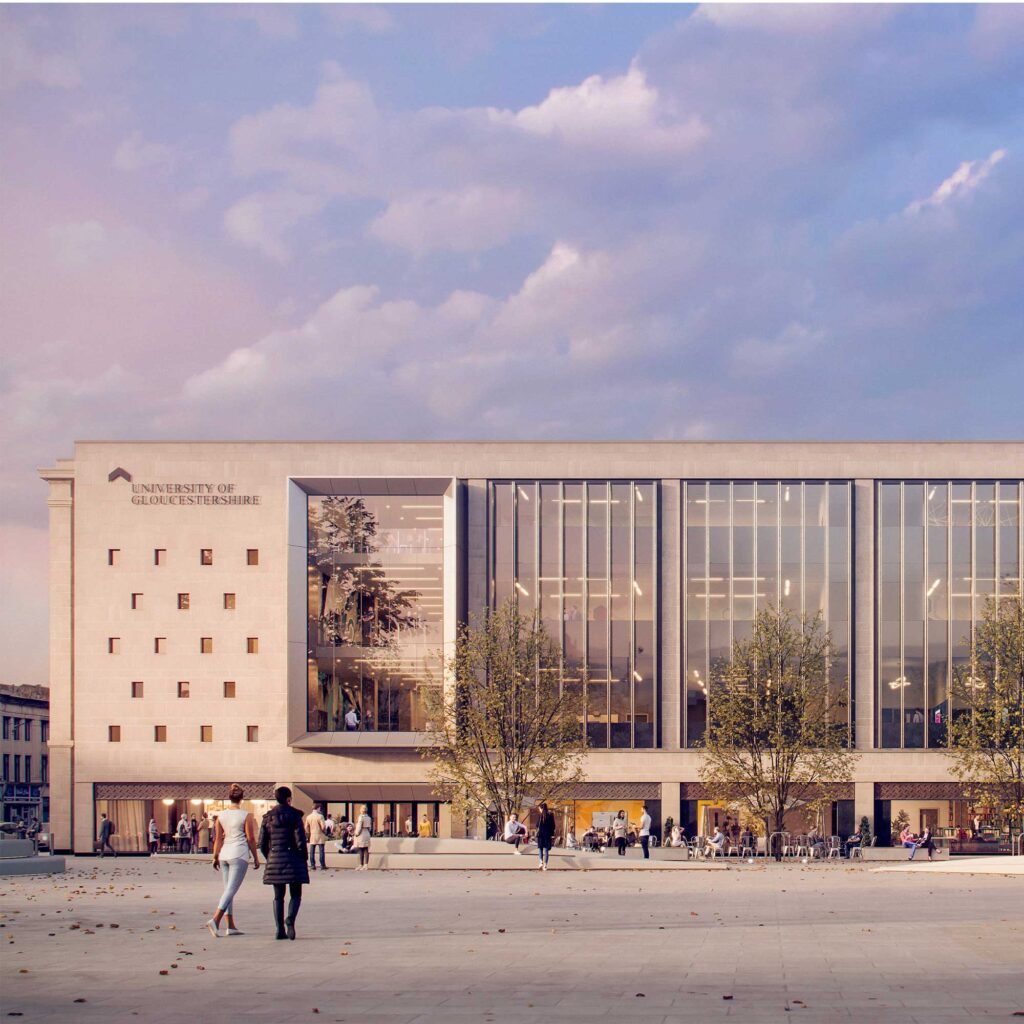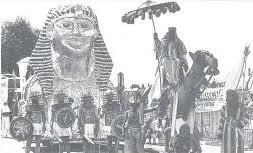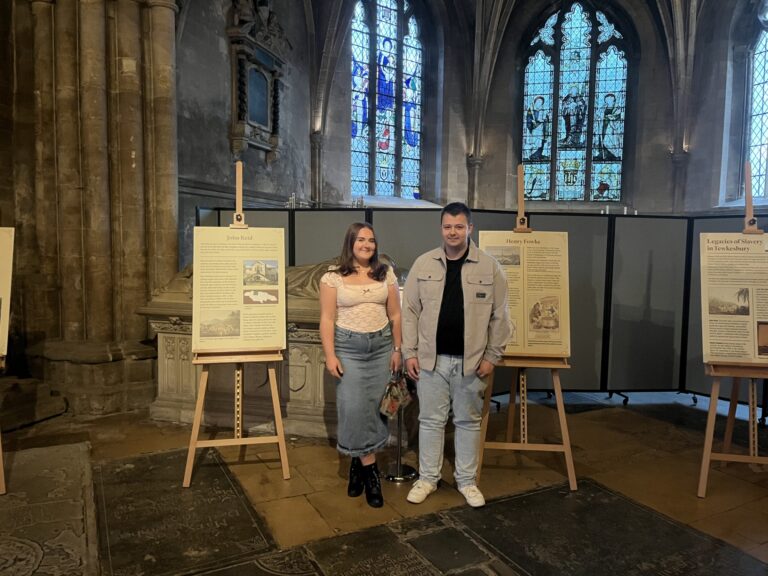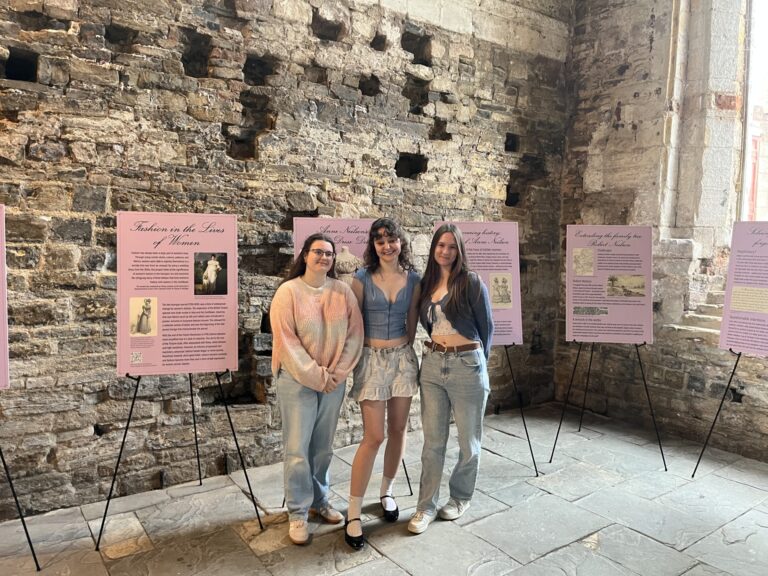| CC4HH
From Department Store to City Campus: Debenham’s Kings Square, Gloucester, Past and Present
This project was conducted by BA History students Sophie Phillips, Nathan Gathercole, Jack Eccles and Kacper Kwiecinski. It was exhibited at the Music Works in Gloucester as part of the City Voices festival in September 2022.
The site of the new addition to the University of Gloucestershire campus buildings has a long and interesting history dating back to Roman times. The late 1800s saw significant redevelopments, expansion and growth in Gloucester city centre. The Debenhams building was a hub for economic growth in the city and resides on a Roman site with long historical links to trade and commerce.
Jump to: Timeline | Redevelopment history | Bon Marche | From Fashion to Flight | Evolution of Kings Square | Rise and decline of retail
Timeline
1889: Bon Marche opened on Northgate Street as a drapery business owned by John Rowe Pope
1909 and 1914: shop extended, and a second identical extension built
1971: Bon Marche building was bought by Debenhams
1927-1929: creation of Kings Square as part of the Oxbode redevelopment plan
1930s: Bon Marche reopened as one of the most modern and largest shopping emporiums in the west of England
1933: the ‘Flying Flea’ small plane kit
1940s: new shops appear on Kings Square, but development was halted by the Second World War.
Gloster Aircraft Company mechanics built a Hurricane fighter in Bon Marche as part of a fundraising week
1965: Bon Marche wins the Corporation Cup award and Chamber of Trade trophy for the best decoration during Gloucester Carnival.
1969: new development plans for Kings Square.
1971: Bon Marche building was bought by Debenhams.
1972: opening of newly refurbished Kings Square. The ambitious design won the Civic Trust award.
1973: re-naming ceremony to change the building’s name to Debenhams.
1980s: Kings Square begins to decline.
2006: some of the area is levelled as an interim solution prior to redevelopment
12 May 2021: Debenhams closed
2022: plans underway for the building to be made into the new University of Gloucestershire City Campus as part of new redevelopment plans to rejuvenate Gloucester city centre.
Redevelopment history
From department store to City campus
Over the years, the Debenhams building has been part of the many redevelopments of Kings Square.

Kings Square was created between 1927 and 1929 as part of the Oxbode redevelopment. Gloucester’s expansion to the south and east involved the demolition of many houses and shops. The construction of Kings Square incorporated many of the surrounding streets: King Street (now Kings Walk), St Aldates Street and New Lane.

Bon Marche
Extensions to the original Bon Marche building (an old advertisement for the store pictured left) took place in 1909 and 1914 and involved the demolition of the Dolphin Vaults pub. The original Bon Marche building was demolished in 1931 leaving only what was to become Debenhams in its place.
In the 1930s, the building was a great economic success. Bon Marche was hailed as the most modern and largest shopping emporium in the West of England. The shop sold a variety of products including a flying vehicle called the ‘Flying Flea. This very small plane was available as a ‘build it yourself’ product.
The area around Bon Marche was supposed to continue growing, with more shops scheduled to appear in the 1940s, but further development was delayed during the Second World War. Kings Square was left as a bus station and a car park, but Bon Marche remained in business.
Recent plans have once again seen the redevelopment of Kings Square with the aim to rejuvenate the city centre. This forward-looking strategy involves the plan for the former Debenhams building to become the new University of Gloucestershire City Campus.

From fashion to flight
Liveried deliveries
Although Bon Marche was best known for its clothing and fashion, the shop, all the way through to the 1940s, also had ties with motors, mechanics and engineering.

Beginning in the 1910s the retailer acquired a De Dion Bouton van (pictured), which was coach built at a workshop in Market Parade, just a few streets away. The motor vehicle had a maroon and gold livery and was used for the first motor transport delivery made by a city store. The van made deliveries not only across Gloucester city but also as far away as Monmouth and Ross-on- Wye, nearly a 100-mile round trip.
The ‘Flying Flea’
Bon Marche continued its ties with the mechanical world in the 1930s. Air travel had advanced significantly from its primitive beginnings in the First World War. Local companies – Handley Page, Bristol Aeroplane Company and Gloster Aircraft Company – all made advances in flight development, and part of this included the idea of personalised air transport.

The idea of the ‘Flying Flea’ (Mignet Pou-du-Ciel) first emerged in France in 1933. It was a small plane sold in kit form. The ‘Flying Flea’ was designed to be an accessible car of the sky. The relatively cheap cost made it popular on the continent before it eventually came to Britain. The purchasers built the plane themselves and flew from suitable runways.
Pictured: Photo of Henri Mignet sitting in the Flying Flea in 1936 next to S.W. Appleby at Lympne Airport in Kent.
The ‘Flying Flea, however, did not have a long life. Mechanical failures and far too many routine accidents led to people losing their lives, and the design was soon banned.
Clothes and more
Bon Marche’s involvement with aviation did not end in the 1930s. During the Second World War the shop hosted a charity fundraising event. It was turned into a workshop for the mechanics of the Glocester Aircraft Company to build a single Hurricane fighter plane for the Allied war effort.
Throughout its existence, Bon Marche sold a wide variety of products, not only clothes and household goods, but also boats and cars, as well as planes, all being offered for sale in the same space.
The building plays an important role in Gloucestershire’s engineering history, and this is one of its many achievements.
Evolution of Kings Square
The 1960s extension was designed and carried out by the architecture practice Healing and Overbury, which had already worked on several extensions for other Debenhams properties. The extension came as a direct result of the acquisition of St. Aldates Garage which afforded the Bon Marche a direct presence on Kings square, albeit at the cost of a neighbouring building having to be demolished to make way for the extension.

In 1971, Bon Marche was acquired by Debenhams. In 1973, the name of the building was finally changed to Kings Square Debenhams. This development reflected the certain degree of economic growth in the area. Some of the residential streets in Gloucester were going through stages of gentrification.
The commercial properties around Kings Square were experiencing major retail growth. The redevelopment of Kings Square in 1972 was one of the most ambitious city centre projects in this part of the country. Much like the rest of the area, however, as shopping practices changed, in later years Kings Square went into decline and many local businesses experienced major stagnation.
Rise and decline of retail
Located near the River Severn and dating back to the Roman times, Gloucester has always been a place of commerce. This city’s commercial and cultural influence was, and still is, significant.
From the end of the 17th century, Gloucester city’s natural and artificial strengths allowed it to develop as a regional market centre.
The outcome of many of the city’s grandiose construction projects, such as what was to become the Debenhams building, allowed commercial companies to stake their claim in the growing local economy. Retailers established themselves as powerhouses with impressive architectural developments in the heart of the city.
Bon Marche placed notices of its festive presentations and events in local newspapers, including The Citizen. It cemented its position as a cornerstone of local everyday life. The Citizen published images of staff events and the gala days hosted by the store, and it documented the extension added to the building in the early 1960s.

In 1965, Bon Marche again took the spotlight. The shop’s employees entered the local carnival with the biggest and by far the most extravagant float in the form of a sphinx (pictured), with the shop workers dressed in Egyptian-inspired attire. The float won the Corporation Cup award and Chamber of Trade Trophy for the best decoration.
Community impact
From the 1950s and during the following decades, with its central location, Bon Marche and then Debenhams stood at the retail heart of Gloucester city centre. The shop provided not only Saturday jobs for young people, but also prestigious and somewhat glamorous full-time employment for many. The shop’s festive and extravagant window displays attracted large crowds, particularly during the Christmas period.
Former retail assistant, Maxine Nemes, details her memories of working at Debenhams on Gloucestershire Live.
If you worked or shopped in Bon Marche or Debenhams, what do you remember about the store?



